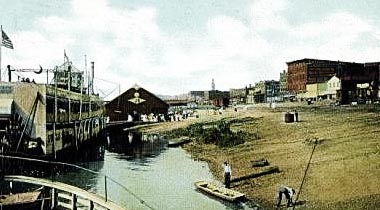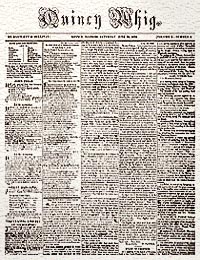
READINGS IN EARLY MORMON HISTORY
(Newspapers of Illinois)

Adams County, Illinois
Quincy Whig, Herald, &c.
1847-49 Articles

Quincy, Illinois, Steamboat Landing, 1850s
1838 | 1839 | 1840 | 1841 | 1842 | 1843
1844 | 1845 | 1846 | 1847-9 | 1850-69 | post 1869
|
Jan 13 '47 | Jan 27 '47 Feb 03 '47 | Mar 10 '47 | Mar 17 '47 Mar 31 '47 | May 19 '47 | Jun 16 '47 Jun 23 '47 | Sep 15 '47 | Oct 13 '47 Dec 22 '47 | Mar 15 '48 | Oct 09 '49 |

|
Peoria papers | Alton Telegraph | Misc. Ill. papers
Illinois Journal | Warsaw Signal | Hancock Eagle
Return to: Old Newspapers Articles Index
 Vol. IX. Quincy Illinois Wednesday, January 13, 1847. No. 39. HONOR TO THE DEAD. We frequently have heard the suggestion that some public demonstration should be made by the people of Hancock County, in honor of our fellow-citizens who lost their lives in unhappy difficulties of the Mormons. The suggestion is a very reasonable one. It is right that our citizens should in some manner, express their regard for those who were thus ruthlessly snatched away from them. It is right that they should demonstrate to the world that they revere the memories of the slain, and that they mean to defend them against all unjust imputations, come from what quarter they may. |
 Vol. IX. Quincy Illinois Wednesday, January 27, 1847. No. 41.
HONOR TO THE DEAD. -- The Warsaw Signal recommends that a plain column as a Monument, be erected in Hancock, on some eligible point at [an] expense of a few hundred dollars, in memory of the virtues of those who were murdered by the Mormons. As to the means, the editor proposes that a handsomely bound book be provided in which to record the names of contributors, with certificates for each, stating the amount, and the purpose for which it was paid, and when full to be deposited and kept in the office of the County Recorder, as a memorial -- no individual to contribute more than 50 cents, that all who desire may have an opportunity to share in the work. A committee of ten to be appointed -- five at the county seat and five from the country -- who with the treasurer, to be a building committee, to plan, contract, construct, and pay for the same, and finally make report of their proceedings. |
 Vol. IX. Quincy Illinois Wednesday, February 3, 1847. No. 42.
THE MORMON CHURCH AT VOREE, WISCONSON. -- The Strangite portion of the Mormon Church at Voree, Wisconson, seems to be increasing in numbers, under the dispensation of the new and true Prophet, J. J. Strang -- They have established a paper at Voree, entitled 'Zion's Reveille,' which purports to be the organ of the Church. It seems from this paper that many of the leading Mormons, who were Joe Smith's 'right-hand men' in his most prosperous days, are now at Voree and taking a leading part under the Strang dispensation. Among them are Dr. John C. Bennett, Geo. J. Adams, John Greenhow, and others. The new paper purports to be edited by Greenhow, but it is probably edited by Dr. Bennett. |
 Vol. IX. Quincy Illinois Wednesday, March 10, 1847. No. 47.
THE MORMONS IN IOWA. -- The ruling passion appears to be strong with the people wherever they locate. The editor of the Burlington Hawkeye, corresponding with his paper from Iowa City, notices an arrival at that city of a delegation of the brethren, under rather unfavorable auspices. Iowa, from present appearances, is in a fair way to become as much excited on the subject of Mormon thieving, as were the "wicked populous" of Hancock. The Gentiles of Iowa ought to be ashamed of themselves for "persecuting" the Saints for stealing their property. Where is the author of the "Leading Causes?" |
 Vol. IX. Quincy Illinois Wednesday, March 17, 1847. No. 48.
BURCH AT LARGE! -- The notorious Robert H. Burch, one of the gang concerned in the murder of Col. Davenport, of Rock Island, who was waiting his trial, which was to take place at the next sitting of the Court, broke jail on the night of the 2nd inst., from the jail of Knox county, at Knoxville. We were informed by the Sheriff of Knox county, that he made his escape by removing in some way the flooring of his cell, and so digging his way to the outer wall, which was composed of heavy stone work; and he removed, by what means is to us a wonder, heavy stones from the wall, and through which he, with another prisoner, made his escape. -- |
 Vol. IX. Quincy Illinois Wednesday, March 31, 1847. No. 50.
There is likely to be a difficulty between the Mormons and the Indians in the Upper Missouri. The "Leading Cause" is, that the brethren have taken some of their habits with them from Hancock, and cannot leave the property of even the poor Indians unmolested. |
 Vol. 10. Quincy Illinois Wednesday, May 19, 1847. No. 5. A MORMON PAPER IN CALIFORNIA. The Mormons have commenced a paper in California, at a place called Yerba Buena. It is conducted by one S. Brannan, who is said to have been brought up by Joe Smith, and of course well qualified to unfold the tenets of the saints. |
 Vol. 10. Quincy Illinois Wednesday, June 16, 1847. No. 9. THE TEMPLE SOLD. We learn from the Warsaw Signal, that the Mormon Temple at Nauvoo, is finally sold to a committee of the Catholic Church for $75,000. The assent of the Bishop was required before the bargain would be complete. |
 Vol. 10. Quincy Illinois Wednesday, June 23, 1847. No. 10.
We hear certain individuals are in limbo in Nauvoo, for counterfeiting County orders, among other things. Can the Signal enlighten us? -- (Quincy Whig). |
 Vol. 10. Quincy Illinois Wednesday, September 15, 1847. No. 22.
In the last 'Reveille' of the Strang dy-NASTY, at Voree, we find the following: |
 Vol. 10. Quincy Illinois Wednesday, October 13, 1847. No. 27.
A new Democratic paper entitled the "Hancock Patriot," by J. McKee, has made its appearance at Nauvoo. The editor says Nauvoo is fast filling up with men of substance and respectability, and will one day be a place of considerable importance. |
 Vol. 10. Quincy Illinois Wednesday, December 22, 1847. No. 37.
Supreme J. Court -- Boston. Henry Cobb vs. Augusta Cobb. This was a libel alleging crim-con on the part of the respondent with Brigham Young, in Nauvoo, in August, 1844, and December, 1845. After living 21 years in good repute with her lawful husband, the respondent became led away with Mormonism, leaving her husband, went to Nauvoo, and joined the church there. After a year's trial of the system she returned to Boston, but not being able to content herself there, she made another trip to Nauvoo; returned to Boston again, and again went off, and she is now supposed to be in California with Young. |
 Vol. 10. Quincy Illinois Wednesday, March 15, 1848. No. 49. ENGLISH MORMON EMIGRANTS. We learn from a reliable source that several thousand families, members of the Mormon Church, will arrive at New Orleans during the spring, on their way to join the settlement formed in the Great Salt Lake Valley. An agent of the Mormon Church has been sent to New Orleans to provide passages for the emigrants on boats to this city, to engage transportation for them up the Missouri river, [to the present encampment of the Mormons on the Missouri river], called "Winter Quarters." This encampment is on lands owned by the Omaha Indians, and in the immediate vicinity of Council Bluffs. From that point, or the vicinity they expect every spring to send out all, who are prepared to migrate to the Valley of the Salt Lake. |
 Vol. 12. Quincy Illinois Wednesday, October 9, 1849. No. 27.
THE STATE OF DESERET. -- This is the name of the State the Mormons have organized in the Salt Lake Valley. It seems from an account in the Republican, that a Convention to form a Constitution has been held. The Constitution describes the boundary of the new State, and in other respects patterns after our State Constitutions -- the committee to draft the Constitution, were Alfred Carrington, Jas. L. Heywood, Wm. W. Phelps, David Fullmer, John S. Fullmer, Charles C. Rich, John Taylor, Parley P. Pratt, John M. Bernhisel, and Erastus Snow. All of these names will be recognized, as prominent individuals, among the Mormons, during their career in Hancock County. The officers chosen for the new State, are Brigham Young, Governor; Heber C. Kimball, Lt. Governor; Wm. [sic] Richards, Secretary of State; W. M. Clayton, Auditor; Jas. K. Heywood, Treasurer. Almon W. Babbitt was elected by the Legislature, as a Representative of the State of Deseret, in Congress. |
Back to top of this page.
Articles Home Page | Newspaper Articles Index | History Vault
Oliver's Bookshelf | Spalding Studies Library | Mormon Classics
last updated: Jan. 1, 2006